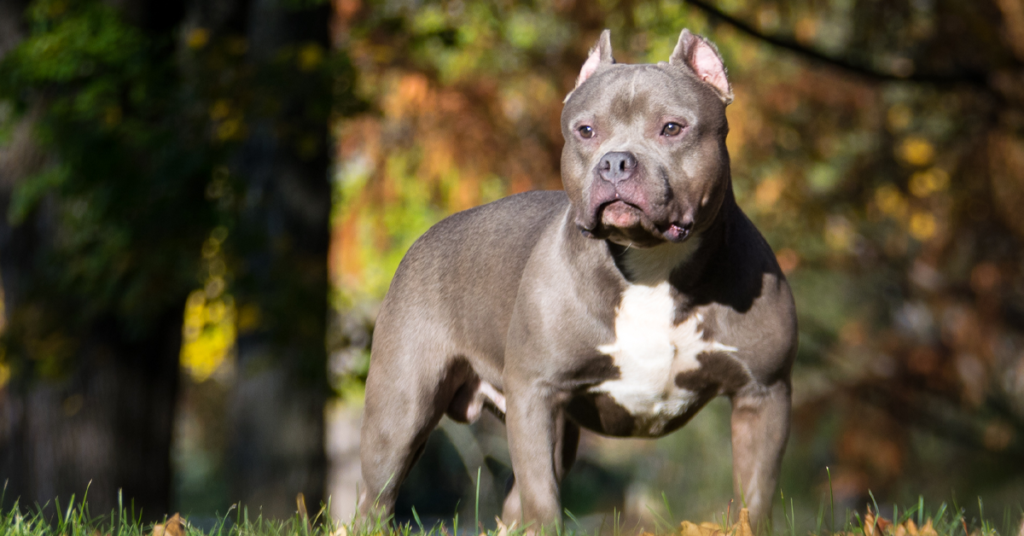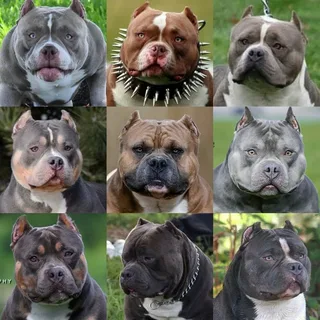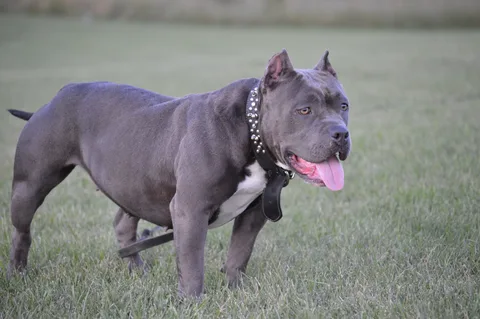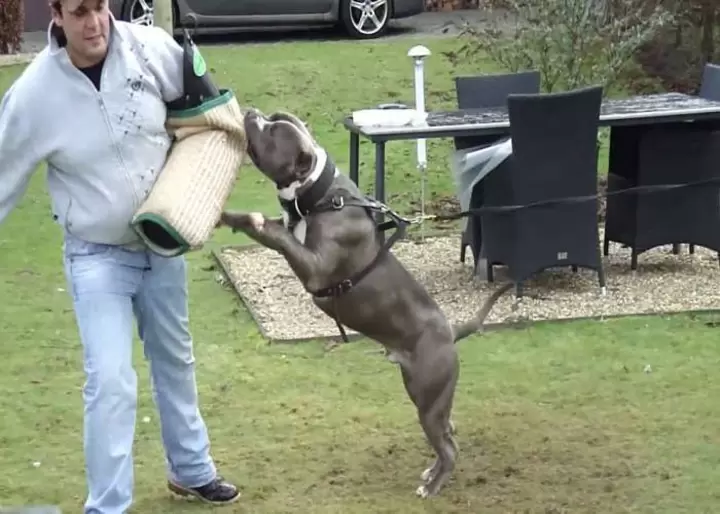The Blue American Bully is a relatively new breed that was developed in the United States in the 1990s through selective breeding programs. Breeders sought to take the bullish strength and muscular build of older Mastiff type dogs and combine it with more affectionate and docile traits suitable for family living.
They started primarily with the fiercely muscled American Bulldog and the athletic American Staffordshire Terrier. These two breeds provided the physical foundation strong bones, muscular bodies, and tenacious energy and drive. Beyond these, other Mastiff type breeds like the American Pit Bull Terrier and English Bulldog were occasionally outcrossed to refine certain traits.
The goal was to establish a new breed paradigm one with massive power, resilience and guardian instincts tempered by a very mild, amiable demeanor. It took nearly a decade of careful planned breeding’s before the first Blue American Bully meeting breed standards in conformation and temperament emerged. Registered with the UKC initially, they gained recognition as a purebred in 2014.
Physical Traits and Size Variations
As established Mastiff hybrids, Blue American Bullies are substantive dogs built for strength rather than speed. They have a short, smooth coat that comes in myriad colors but the classic hallmark is a deep steel blue grey. Their bulky frames are muscular through thick shoulders, deep chests and thick limbs.
Males tend to be the largest, averaging 20-30 inches at the shoulder and 50-125+ pounds as adults. Females are slightly smaller, typically 20-26 inches and 40-90 pounds full grown. Some selective breeding’s have produced even larger “super bully” class specimens surpassing 150 pounds. Regardless of size, all share a square and robust physique.
Their broad heads hold wide set muscular jaws, thick necks and slightly shortened muzzles for their trademark smile. Large, forward facing eyes in hues of brown, amber or blue enhance their kindly, docile facial expressions. Well furred ears are Rose or half pricked in carriage with thick paws completing their formidable appearance.
Average Size Ranges for Male and Female Blue American Bully
| Gender | Height (inches) | Weight (pounds) |
| Male | 20-30 | 50-100 |
| Female | 20-26 | 30-80 |
As you can see from the table, male Blue American Bully tend to reach the larger end of the size spectrum, often breaking 100 pounds or more when fully grown. Females tend to be smaller at 30-80 pounds on average.
A Calm, Loving Temperament
Despite looking built for battle, the Blue American Bully’s signature trait is an exceptionally sweet, tolerant nature.
From infancy, puppies display placid temperaments curious about their human companions. With age, their easygoing personalities deepen into calm confidence and affectionate bonds with their beloved families.
Socialization is still recommended to avoid any shyness or aggression issues.
However, properly raised in homes, these gentle giants thrive as docile pets tolerating children, pets and strangers with patience.
Their love of human company means they tend to attach strongly to one or few special people forming a guardian-like role. Loyalty, protectiveness and cheerfulness define their temperament.
Care Requirements as Family Pets
Like all dogs, Blue American Bullies need regular vet care, vaccinations, heartworm/flea prevention and quality nutrition.
However, as a large breed, some specific needs arise. Quality large breed puppy food supports healthy bone and joint growth as they develop. As adults, carefully monitored caloric intake prevents weight gain risks.
Being at higher risk for musculoskeletal issues, preventative joint supplements (eg glucosamine) can benefit bullies.
Breeders recommend early socialization to avoid tendencies toward stranger shyness or fear biting defensive behaviors if threatened as a protective instinct kicks in.
Regular brushing keeps their short coats looking smart alongside monthly nail trims. Daily exercises such as 30-minute walks or playtime outdoors and indoors provide mental stimulation and prevent boredom. Early obedience training establishes well-behaved manners whether in public or home alone for periods.
Training Techniques That Work
Given their intelligence and desire to please, bullies excel with positive reinforcement techniques. Consistency is key using the identical commands each time and immediately rewarding ‘good dog’ behaviors with praise, toys or treats. Food motivated, they learn basic commands like ‘sit,’ ‘stay,’ ‘come’ within a few repetitions.
Avoid confrontational training methods relying on force or harshness as this can damage the sensitive natures Blue American Bullies possess.
Begin young socializing them to appreciate handling, vet visits, car travel, strangers of all types including other pets and children calmly. Crate training assists with housetraining and any separation anxiety issues.
At home, bully proof gating prevents unwanted behaviors from developing without restricting exercise. Manage interactions with unknown dogs until solidly trained in obedience and introduction protocols.
Overall, a moderate intensity workout routine tailored to their age and condition along with mental stimulation prevents both fitness issues and boredom/destructive outlet seeking.
Health Concerns to Monitor
With a lifespan of 10-14 years on average, certain hereditary health issues warrant screening in the responsible breeding of Blue American Bully. Hip and elbow dysplasia causing painful arthritis is an orthopedic concern especially in oversized or overweight dogs.
Other joint anomalies can potentially occur such as shoulder luxation. Due to their protective traits, rarely do these laidback breeds display overt aggression towards humans.
Nonetheless, any breeding stock exhibiting signs of excessive reactivity should be spayed/neutered to eliminate those traits from future bloodlines.
Often brachycephalic, long term dental or respiratory complications may arise from conformations producing shortened muzzles and undershot jaws.
Breeders strive to balance functional structure with a smiling bull appearance. Yearly vet checks including cardiac auscultation provide early detection opportunities for aortic stenosis, ventricular septal defects and other less common hereditary heart malformations.
Conclusion
When raising these gentle Mastiff hybrids, understanding their origins and needs fosters well-adjusted, healthy pets. Blue American Bully find joy simply living alongside their families with minimal exercise or grooming demands. Their nature to calmly tolerate family chaos including active children earns them the deserved title of favorite household guardians and playmates. Developed through purposeful genetics, these muscular “gentle giants” succeed as affectionate family dogs.
FAQs about the Blue American Bully
Are Blue American Bullies high maintenance dogs?
Despite their large size, Blue American Bullies are quite low maintenance. Their short coats require little more than occasional brushing to stay clean. Their calm demeanor also makes them inclined to relax at home rather than needing constant activity and stimulation like some high energy breeds. Daily walks or play sessions are sufficient exercise for most.
Do they get along with other pets?
As a breed with gentle dispositions, Blue American Bullies typically coexist peacefully with other dogs and pets when properly socialized. Like any dog, introductions should be supervised initially until trust and respect is established. With consistent positive reinforcement training across all family members, these big softies readily accept cats, small furriers and even livestock as non-threatening.
Are they suitable for first time owners?
While Blue American Bullies have very friendly natures, their sheer size means they are not necessarily the best first dog for every new owner. Experience with powerful breeds and commitment to training is preferable. That said, these affectionate dogs can do well as a first pet provided the owner thoroughly researches their needs, establishes an exercise/feeding routine, and seeks guidance from mentors experienced with Mastiff types.
How much do they usually cost?
Professional breeders selling Blue American Bullies as family raised, socialized and healthy pets typically price puppies between $1200-$2500 depending on gender and quality of bloodlines. Adopting an adult or senior bully from a shelter may cost $300-800 with vaccines and neuter/spay already performed. Always research the reputation and health testing practices of any breeder carefully before making such a large purchase.
How much exercise do they need daily?
A growing Blue American Bully puppy benefits from 2-3 short walks, play sessions or interactive toy time breaks daily to properly burn mental and physical energy without stressing young joints. For adult bullies, 30-60 minutes of walking, jogging, playtime or interactive toys keeps them fit without overexerting them. As a lower energy breed content to relax, they don’t require strenuous exercise daily like some working or sporting breeds.

Hello! I am Methew Hills and I am from USA. I am a professional SEO content writer since 2018 and i am also a Teacher.











